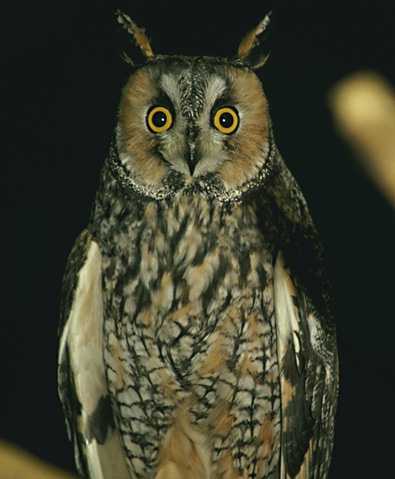

 Good day to you. I guess you are here because you want to learn all about me, "The long Eared Owl". Well since my female partner is tending to our little ones at the moment I will tell you all about us. We have also been known as the American Longeared Owl, the Brush Owl, the Cat Owl, the Lesser Horned Owl, the Cedar Owl and the Coulee Owl. We are medium-sized, nocturnal woodland owls and live mainly in North America, Eurasia and northern Africa. We are on the slim side and have prominent ear tufts that sit in the middle of our heads and are usually erect. Our plumage is brown and buff and we have heavy stripes over most of our bodies. Our eyes are a golden yellow encircled by black feathers and we have a orange-brown facial disk. Our foreheads are spotted with grey and white and we have a white chin patch. Our bills are black and our legs and feets are heavily feathered. We sure do sound like a handsome lot don't we? We are also very talented fliers and can maneuver and fly thru fairly dense brush. Oh yes I almost forgot, and believe me that doesn't happen very often, we are about 14" long and weigh in at about 10 oz. We may be small but we are mighty. When we are trying to get a hold of our female we have a low "hoo, hoo, hoo" sound and can repeat that up to 200 times. Hopefully she hears me before that as it can get tiresome. Also when we get scared and I am not ashamed to admit that, we bark and it sounds like "whek, whek whek" or we have been known to shriek like a cat. As I said before we are nocturnal and so we hunt mainly at nite. We like mice, squirrels, gophers, doves, rabbits, moles, and blackbirds. We are not fond of insects, frogs or snake they have a icky taste. Ok now here again I wish my female was here to explain our breeding habits but I guess I can do it. We usually breed from March thru May but I start courting her in late winter. I fly around the nest and perform great feats gliding and flapping thru the trees and I usually make a very good impression. Our nests are usually in wooded sites hidden by bushes and shrubbery. My female is very good at defending her nest she will flair her feathers and lower her head this make her appear 2-3 times as large as she really is. If need be we will attack with our talons after all we our defending our soon to be born babies. My female usually lays about 4-5 eggs and our babies are born in about 30 days.Our young start to walk around at about 3 weeks but can't fly till they are about 5 weeks. Of course it goes without saying we have the cutest babies of all. Hoot Hoot! We like to reside in open woodlands, on the edges of forests, land along a river or wooded ravines and gulleys.We also like caves and rock canyons. We pretty much live all over the United States from southern California to as far east as Pennsylvania and the mountains of West Virginia. Well I think that's about it. I hope you know a little more about us then you did before. My partner and I are on our way to go and look for more food for our family, a never-ending task. You guys take care and if you look up in the sky some nite and see a graceful owl darting around it just might be me.
This is a report about the Long Earred Owl I found on the internet
Long Eared Owl Thanks to A.J.
|

..and for more...Previous Page:Next Page: Index of Owls Page: Back to Start Page
|
||